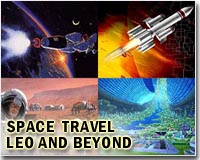 |
for Astrobiology Magazine Moffett Field CA (SPX) Jul 21, 2010 One of the more counterintuitive aspects of the PLRP is the participation of astronauts in the project. NASA astronaut Mike Gernhardt has been a DeepWorker pilot at Pavilion Lake since 2008; this year he was joined by NASA astronaut Stan Love and Canadian Space Agency astronaut Chris Hadfield, both here for the first time. Over the past few days I spent some time with Love and Hadfield, watching them go through their pre-flight checkouts, talking with them about their impressions of the work at the lake, and sitting in on a post-flight pilots' meeting. "Being in a submarine is like being in a spaceship," Love said. "You're in a little enclosed artificial environment. You've got to pay attention to what you're doing. You've got to pay attention to your vehicle. You've got to pay attention to life-support. So there are a lot of similarities. It feels like being in a space suit." Although, as Hadfield pointed out, "In a suit a miscalculation will kill you almost instantly....It's the difference between a high-wire act and walking down a sidewalk. They're both walking, but one of them takes a lot more care in order to stay safe and one you can almost take for granted and think about doing other things." Not surprisingly, piloting a sub requires much less training than becoming an astronaut. Before being cleared to fly aboard the Space Shuttle to the International Space Station (ISS), Love said he spent nearly a decade in training. In preparation for piloting the DeepWorkers, "they emailed me the manual, I read it on the plane going up to Vancouver, they gave me a one-hour brief on the dock, stuck me in the vehicle, plunked me in the water, and I was driving around." As Gernhardt explained to me back in 2008, the value to NASA of having astronauts pilot DeepWorkers is that it provides an opportunity, within the context of a high-risk environment, to study ways of integrating two seemingly opposed approaches to exploration. On an ISS space walk, for example, everything is done according to strict procedure. A mission gets high marks if everything goes according to plan. But that doesn't necessarily work for scientific exploration, because until you start exploring a new place for the first time, you're not sure what you're going to find. It may be more important not to miss something scientifically interesting than to execute a prescribed plan to the letter. "In a NASA operation, a military operation, everybody knows exactly what they're supposed to be doing. Chaos can still ensue, but there's a clear established chain of command," Love said. "When a science principal investigator is involved, who doesn't have that background, they tend to be a little more loosey-goosey.... It may seem a little chaotic and unstructured to somebody with a military background." Like Hadfield, for example. Love's background is in physics and astronomy. Hadfield has some science background, but before becoming an astronaut his studies focused on engineering and he worked as a military test pilot. He saw the problem a little differently. "I think there's no shortage of science here. I think what there is a shortage of is operations," he said. "How can you get operational lessons out of Pavilion Lake that are not specific here, that then can be used in other explorations?" he asked. And in answer to his own question, he said, "You need to generalize the processes. You need to write things down. You need to not rely on word of mouth and experience of how we did it last year in order for it to happen this year." And indeed, one of NASA's goals for PLRP is to develop metrics for quantifying the scientific return of a flight, and a procedural approach for maximizing that return. During each flight, DeepWorker pilots capture continuous video of what they see out the window, and record a running audio commentary, time-synchronized to the video. Twice a day, the pilots meet to review selected segments of that video, assessing the quality of the images and the thoroughness and accuracy of the commentary. They also check to make sure a pilot didn't go zipping past anything important without taking note of it. In an effort to quantify all this, each pilot assigns numeric scores to various aspects of the data return from the flight. But just as the debate continues over whether Pavilion Lake's microbialites are the product of biology or of chemistry, the debate also continues over how loose or how rigid to be while conducting scientific exploration in a novel environment. It's too early to say how the question will ultimately be resolved. As Love put it, "There's more than one way to explore a planet."
Share This Article With Planet Earth
Related Links the missing link Space Tourism, Space Transport and Space Exploration News
 Inventors unveil commercial spacesuit
Inventors unveil commercial spacesuitNew York (UPI) Jul 19, 2010 Two inventors, one American and one Russian, unveiled their design for a commercial spacesuit in New York, officials said. Moscow spacesuit engineer Nikolay Moiseev and New York inventor and artist Ted Southern formed a partnership they call Final Frontier Design and hope to attract commercial space companies like SpaceX, Orbital Sciences and Virgin Galactic as customers, SPACE.com repo ... read more |
|
| The content herein, unless otherwise known to be public domain, are Copyright 1995-2010 - SpaceDaily. AFP and UPI Wire Stories are copyright Agence France-Presse and United Press International. ESA Portal Reports are copyright European Space Agency. All NASA sourced material is public domain. Additional copyrights may apply in whole or part to other bona fide parties. Advertising does not imply endorsement,agreement or approval of any opinions, statements or information provided by SpaceDaily on any Web page published or hosted by SpaceDaily. Privacy Statement |